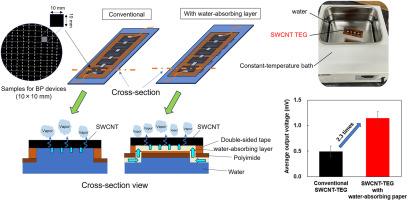Enhancing heat-source free water-floating single-walled carbon nanotube thermoelectric generators with water-absorbing paper
IF 7.9
2区 工程技术
Q1 CHEMISTRY, PHYSICAL
引用次数: 0
Abstract
Thermoelectric generators (TEGs) are a promising energy-harvesting technology that convert ambient thermal energy into electrical energy. However, their reliance on hot and cold sources to establish a temperature gradient remains a challenge. Water-floating single-walled carbon nanotube (SWCNT) TEGs address this limitation by self-generating a temperature gradient through evaporative cooling in specific areas. Despite this advantage, their temperature gradient is relatively small, leading to a low output voltage. In this study, we embedded water-absorbing paper into SWCNT-TEGs to enhance the temperature gradient and improve performance. Six types of paper with varying water absorbencies were tested, and the performance of the SWCNT-TEGs was evaluated. The output voltage increased with water absorbency, reaching 1.14 ± 0.13 mV–2.3 times higher than a conventional SWCNT-TEG—when placed in 60 °C water without sunlight. This improvement resulted from enhanced evaporative cooling, which increased water vapor generation and amplified the temperature gradient in the SWCNT films. One possible mechanism for enhanced evaporative cooling is enhanced capillary forces at the rough interface between the SWCNT film and the water-absorbing paper, where a thin water film exists. Our findings demonstrate that embedding water-absorbing paper can significantly enhance the performance of water-floating SWCNT-TEGs.

用吸水纸增强无热源浮水单壁碳纳米管热电发电机
热电发电机(teg)是一种很有前途的能量收集技术,它将环境热能转化为电能。然而,它们依赖冷热源来建立温度梯度仍然是一个挑战。水浮单壁碳纳米管(SWCNT) TEGs通过在特定区域的蒸发冷却自行产生温度梯度,解决了这一限制。尽管有这种优势,但它们的温度梯度相对较小,导致输出电压较低。在这项研究中,我们将吸水纸嵌入到swcnts - teg中,以增强温度梯度并提高性能。对6种不同吸水率的纸张进行了测试,并对swcnts - teg的性能进行了评价。输出电压随着吸水率的增加而增加,当放置在60°C没有阳光的水中时,输出电压比传统swcnts - teg高1.14±0.13 mV-2.3倍。这种改善是由于蒸发冷却的增强,这增加了水蒸汽的产生,扩大了swcnts薄膜的温度梯度。增强蒸发冷却的一种可能机制是在swcnts薄膜和吸水纸之间的粗糙界面(存在薄水膜)上增强毛细力。我们的研究结果表明,包埋吸水纸可以显著提高水浮swcnts - teg的性能。
本文章由计算机程序翻译,如有差异,请以英文原文为准。
求助全文
约1分钟内获得全文
求助全文
来源期刊

Journal of Power Sources
工程技术-电化学
CiteScore
16.40
自引率
6.50%
发文量
1249
审稿时长
36 days
期刊介绍:
The Journal of Power Sources is a publication catering to researchers and technologists interested in various aspects of the science, technology, and applications of electrochemical power sources. It covers original research and reviews on primary and secondary batteries, fuel cells, supercapacitors, and photo-electrochemical cells.
Topics considered include the research, development and applications of nanomaterials and novel componentry for these devices. Examples of applications of these electrochemical power sources include:
• Portable electronics
• Electric and Hybrid Electric Vehicles
• Uninterruptible Power Supply (UPS) systems
• Storage of renewable energy
• Satellites and deep space probes
• Boats and ships, drones and aircrafts
• Wearable energy storage systems
 求助内容:
求助内容: 应助结果提醒方式:
应助结果提醒方式:


